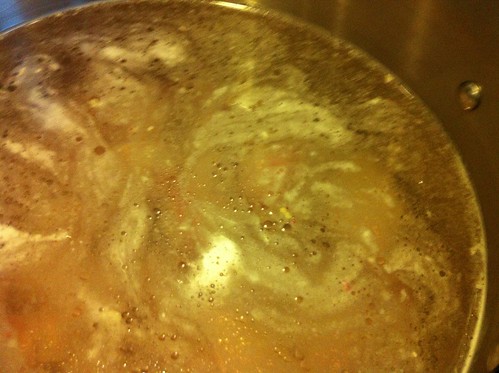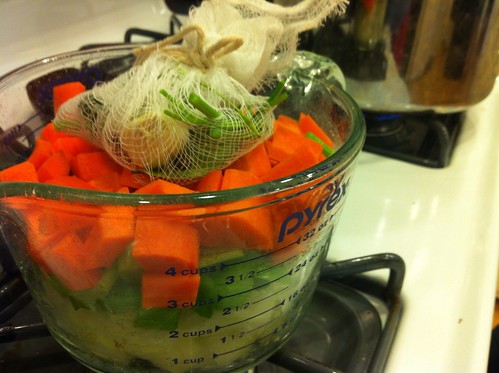I made my own chicken stock this weekend! We're forging ahead in The Professional Chef
The recipe called for 8 lbs of chicken bones, but when I went to the store, and asked the meat department for said chicken bones, they said that all of their poultry is packaged already when it is delivered. That's what I get for going to a store without a proper butcher department (next time, I'll try this!). I opted for two packages of bony chicken wings, to substitute as an ingredient for my stock. In the end, I think this made the stock a bit more gelatinous when cooled, but all it needs is a little heat to loosen right back up.
This was going to be a 4-hour process, so I started as soon as my groceries were delivered on Sunday afternoon! (Yes, thank you Peapod!) I put a gallon of water into a nice, big stock pot, and added the chicken wings, which I rinsed before adding them. I salted the mixture and set it to simmer for the next 3 hours.
While the stock simmered, I did a few things around the house, started to make dinner, and then set to prepping my mirepoix (onion, carrot and celery). Because of the time that the veggies would be simmering, I cut them to a medium dice, and also pulled together a Sachet d'Epices, a little bouquet of parsley stems, thyme, peppercorns, a bay leaf and a clove of garlic.
After the three hours had expired, I turned off my timer and checked out the stock, so far. It had evaporated quite a bit, so even though the recipe didn't call for it, I added some more water. I don't know if I was supposed to do that, but it tastes REALLY good, so we'll just go with it. I added the beautiful mixture you see above to the simmering liquid and chicken wings, and allowed it to cook for another hour.
Once the timer went off a second time, it was time to remove the stock from the heat, and give it a good strain in a fine, mesh sieve. All the impurities are left behind and what you have left is a big bowl of delicious, flavorful, homemade stock.
I've already used a cup of it in one of my weekly meals, and it's so good. It adds so much authentic flavor to a dish, it's incredible! I will definitely be making stock on weekends for the coming week, according to my needs.
While there are other recipes for stocks (Brown Veal Stock, Fish Fumet, Vegetable Stock, Court Bouillon, Dashi, and a Poultry and Meat Stock), I'm not going to use these recipes until recipes further on in the book call for them specifically. There's no point in filling my freezer with unneeded stocks. Because the lessons for stocks, soups and sauces come before the recipes, I think I'll do a bit of reading this weekend and try to move ahead to the recipes, where I can share what I've learned while making some delicious recipes at the same time! Now's the perfect time of year for some heartwarming soups, anyway. We're ready for spring, it's not quite here, and we all need something to warm our bellies!






